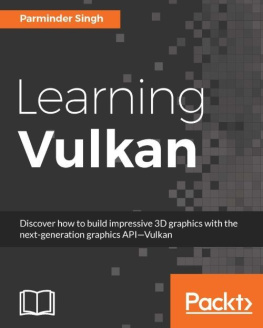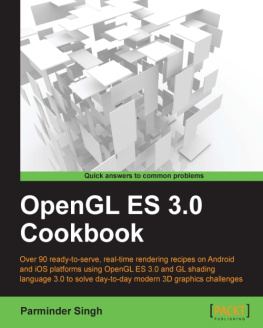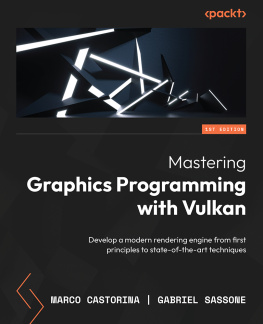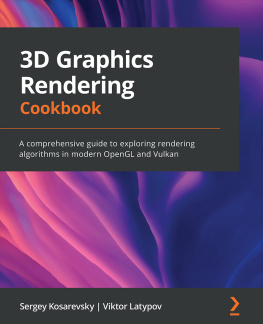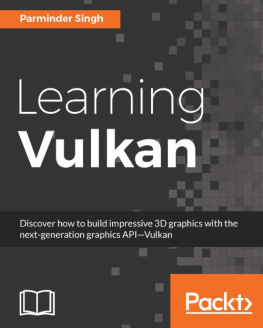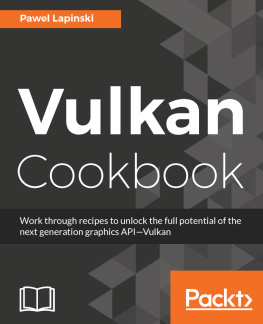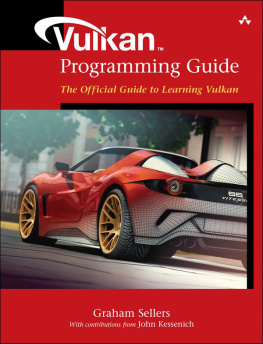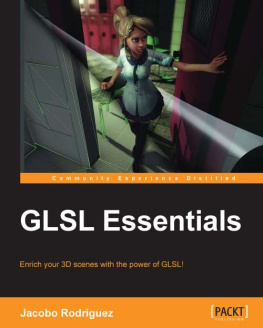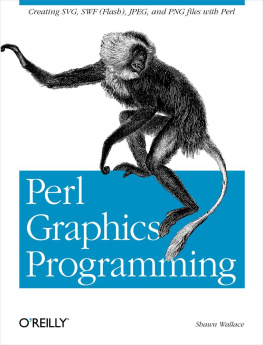Learning Vulkan
Copyright 2016 Packt Publishing
All rights reserved. No part of this book may be reproduced, stored in a retrieval system, or transmitted in any form or by any means, without the prior written permission of the publisher, except in the case of brief quotations embedded in critical articles or reviews.
Every effort has been made in the preparation of this book to ensure the accuracy of the information presented. However, the information contained in this book is sold without warranty, either express or implied. Neither the author, nor Packt Publishing, and its dealers and distributors will be held liable for any damages caused or alleged to be caused directly or indirectly by this book.
Packt Publishing has endeavored to provide trademark information about all of the companies and products mentioned in this book by the appropriate use of capitals. However, Packt Publishing cannot guarantee the accuracy of this information.
First published: December 2016
Production reference: 1121216
Published by Packt Publishing Ltd.
Livery Place
35 Livery Street
Birmingham
B3 2PB, UK.
ISBN 978-1-78646-980-9
www.packtpub.com
Credits
Author Parminder Singh | Copy Editor Gladson Monteiro |
Reviewer Chris Forbes | Project Coordinator Ritika Manoj |
CommissioningEditor Ashwin Nair | Proofreader Safis Editing |
AcquisitionEditors Smeet Thakkar Aaron Lazar | Indexer Rekha Nair |
Content Development Editor Sachin Karnani | Production Coordinator Aparna Bhagat |
Technical Editor Murtaza Tinwala | Graphics Abhinash Sahu |
About the Author
Parminder Singh is a computation graphics engineer with Blackmagic Design, Singapore. He has been working and developing graphic applications in the fields of network simulations, geo-modeling, navigation, automotive, infotainment systems, image processing, and post-production for the past decade. His research interests include GPU programming for scalable graphics and compute applications, porting, and performance optimization techniques.
He is a Vulkan, Metal and OpenGL ES trainer and has also authored OpenGL ES 3.0 Cookbook , Packt. His hobbies include traveling, light cooking, and spending quality time with his baby girl.
Feel free to connect Parminder at https://www.linkedin.com/in/parmindersingh18 or you can reach him at http://openglescookbook.com.
Acknowledgments
I dedicate this to my sweet baby girl, Raskeerat, who was born at the same time as we started this project. With a little baby onboard, it's challenging to write a book; I am grateful to my beloved wife Gurpreet Kaur and my family for helping me deliver this project to the community.
I extend my gratitude to Mr. Ulrich Kabatek and the entire graphics team of Continental Automotive; every member of the team had something to offer me to scale my vision of graphics. I am grateful to Blackmagic Design, who helped me extend my horizon to take GPU programming to a whole new level. I express my regards to Mohit Sindhwani and the whole of Quantum Invention's team. It was a great pleasure to work for them and also was a wonderful learning experience.
I am highly indebted to Chris Forbes from Google; his expertise in the graphics domain has raised the bar of this title. I am highly impressed with his reviews and the quality of work he delivered. Chris reviewed this title inch-by-inch and helped us not only to improve the contents but also our understanding of the concepts with his detailed explanation.
Last but not the least, I am thankful to the entire division of Packt, especially Sachin Karnani, who constantly remained involved during the production of this title. Murtaza Tinwala, who brilliantly exhibited his content management and technical skills during the final stages. I'm really happy to have them work with me on this book.
About the Reviewer
Chris Forbes works as a software developer for Google, working on Vulkan validation support and other ecosystem components. Previously he has been involved in implementing OpenGL 3 and 4 support in open source graphics drivers for Linux (www.mesa3d.org), as well as rebuilding classic strategy games to run on modern systems (www.openra.net).
www.PacktPub.com
For support files and downloads related to your book, please visit www.PacktPub.com.
Did you know that Packt offers eBook versions of every book published, with PDF and ePub files available? You can upgrade to the eBook version at www.PacktPub.com and as a print book customer, you are entitled to a discount on the eBook copy. Get in touch with us at service@packtpub.com for more details.
At www.PacktPub.com, you can also read a collection of free technical articles, sign up for a range of free newsletters and receive exclusive discounts and offers on Packt books and eBooks.
https://www.packtpub.com/mapt
Get the most in-demand software skills with Mapt. Mapt gives you full access to all Packt books and video courses, as well as industry-leading tools to help you plan your personal development and advance your career.
Why subscribe?
- Fully searchable across every book published by Packt
- Copy and paste, print, and bookmark content
- On demand and accessible via a web browser
Preface
This book is all about learning Vulkan from scratch. Vulkan is a next-generation cross-platform graphics and compute API. Despite being a successor of OpenGL API, it is a completely fresh approach to redesigning an API from the base that meets the competitive demand of consumers and works very close with the underlying GPU hardware. Vulkan is a software interface that is capable of controlling GPU hardware settings to harness the power of paralleling computing. The driver layer in Vulkan is really thin and puts more responsibilities on the shoulders of an application programmer to manage the application, its resources, memory management, synchronization, and more; this explicit nature of Vulkan makes it verbose. This book allows the beginner to learn such topics in baby steps, covering each chapter with an easy-to-follow companion example. The chapters are laid out in an incremental fashion; each chapter is built on top of the previous one, exposing the modular difference to our readers.
The Vulkan API certainly requires some level of computer graphics or computing knowledge prior to starting programming on it, as many of the concepts or terminologies are very general and directly used throughout this book.
This book is very practically oriented and prepared with an objective to allow its readers to learn Vulkan theory, concepts, and API specification, and see them in action through companion examples. There are plenty of references throughout the book that help readers to refer to the related concept, helping them to recap the fundamentals as they proceed through.

